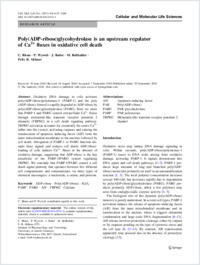Poly(ADP-ribose)glycohydrolase is an upstream regulator of Ca2+ fluxes in oxidative cell death.
- Blenn C Institute of Pharmacology and Toxicology, University of Zurich-Vetsuisse, Winterthurerstrasse 260, Zurich, Switzerland.
- Wyrsch P
- Bader J
- Bollhalder M
- Althaus FR
- 2010-09-30
Published in:
- Cellular and molecular life sciences : CMLS. - 2011
Animals
Calcium
Caspases
Cell Death
Cells, Cultured
Fibroblasts
Gene Expression Regulation
Glycoside Hydrolases
Hydrogen Peroxide
Mice
Oxidants
Oxidative Stress
English
Oxidative DNA damage to cells activates poly(ADP-ribose)polymerase-1 (PARP-1) and the poly(ADP-ribose) formed is rapidly degraded to ADP-ribose by poly(ADP-ribose)glycohydrolase (PARG). Here we show that PARP-1 and PARG control extracellular Ca(2+) fluxes through melastatin-like transient receptor potential 2 channels (TRPM2) in a cell death signaling pathway. TRPM2 activation accounts for essentially the entire Ca(2+) influx into the cytosol, activating caspases and causing the translocation of apoptosis inducing factor (AIF) from the inner mitochondrial membrane to the nucleus followed by cell death. Abrogation of PARP-1 or PARG function disrupts these signals and reduces cell death. ADP-ribose-loading of cells induces Ca(2+) fluxes in the absence of oxidative damage, suggesting that ADP-ribose is the key metabolite of the PARP-1/PARG system regulating TRPM2. We conclude that PARP-1/PARG control a cell death signal pathway that operates between five different cell compartments and communicates via three types of chemical messengers: a nucleotide, a cation, and proteins.
- Language
-
- English
- Open access status
- hybrid
- Identifiers
-
- DOI 10.1007/s00018-010-0533-1
- PMID 20878536
- Persistent URL
- https://sonar.rero.ch/global/documents/235953
Statistics
Document views: 12
File downloads:
- fulltext.pdf: 0
